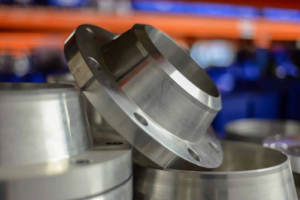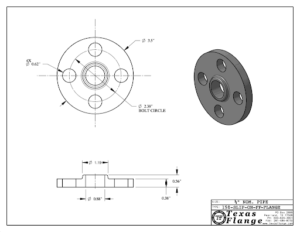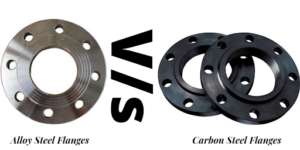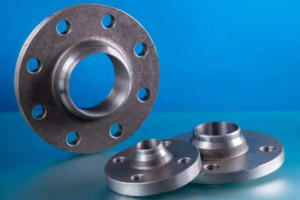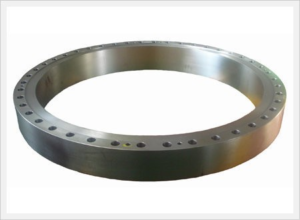Girth flanges are fundamental components in some industrial settings, playing a role in ensuring the reliability of various types of equipment. These essential parts are used to connect different sections of pressure vessels, heat exchangers, and other critical machinery. In this article, we’ll explore the significance of girth flanges, the materials used in their construction, and how they help prevent leaks.
Image source:Texas Flange
Understanding Girth Flanges
Girth flanges may not be the most well-known components, but they’re essential in many industries. Imagine them as the sturdy connectors that hold together different parts of important equipment. Whether it’s a massive pressure vessel or a heat exchanger, girth flanges are there to make sure everything stays securely connected.
Image source:Texas Flange
The Materials Matter
One of the cool things about girth flanges is that they can be made from various materials, depending on what they’ll be used for. Let’s take a look at some of the materials they can be made from:
Image source:Texas Flange
Carbon Steel
A105: A versatile choice for many applications.
A105N/4130 or 4140 : Ideal for some pressure vessels.
Low-Temperature Steel
A350 LF2 CL1/CL2, LF3: Perfect for applications where the material is really cold.
High-Yield Carbon Steel
A694 F52/F60/F65/F70: Known for its strength.
Stainless Steel
A182 F304/L, F304H, F310, F316/L, F317/L, F321/H, F347/H, F44: Resistant to rust and often used in tough conditions.
Low-Alloy Steel
A182 F1, F5, F9, F11 CL1/CL2/CL3, F12 CL1/CL2, F22 CL1/CL3, F23, F91, F92: Suitable for high-temperature places.
Duplex Stainless Steel
A182 F51, F53, F60: Combines the best of both worlds in stainless steel.
Alloy Steel
Alloy 20, Alloy 625/825/800: Offers great corrosion resistance.
Choosing the right material depends on things like where the equipment will be used, how hot or cold it gets, and whether it’s exposed to corrosive substances.
Types of Girth Flanges
Girth flanges come in two common types:
1. Welded Hub Joint
Image source:Texas Flange
These girth flanges have a hub at the ID, making them strong and permanent. They’re great when a reliable connection is a must and matching the ID is a must
2. Loose Type (Without Hub)
Image source:Texas Flange
Unlike the welded hub joint, these girth flanges don’t have a central hub. They are slipped over the shell and welded to the OD.connected, making them more flexible..
Preventing Leaks: Dealing with Thermal Distortion
One big challenge with girth flanges is stopping leaks, which can cost a lot and be unsafe in certain industries. There are several reasons flange joints might leak, and one of them is thermal distortion. Here’s how that works:
Thermal Shocks: When there are sudden and extreme temperature changes, it can make flange joints warp, causing leaks. This is why it is important to ensure the face of the flange is not in the Weld Affected Zone.
Differential Thermal Expansion: Different parts of equipment expand and contract at different rates when they get hot or cold. This can put uneven pressure on flange joints, possibly leading to leaks.
Improper Assembly: If flanges aren’t aligned correctly or the gasket isn’t placed properly, it can create weak points where leaks can happen.
High Vibrations: In some equipment, too much shaking and vibrating can wear down flange joints, making them more likely to leak.
Incompatible Materials: Using the wrong materials to make flanges can lead to corrosion and less effective sealing over time.
Analysing Thermal Shock Scenarios
To prevent leaks due to thermal distortion, it’s crucial to look at how temperature changes affect girth flanges. There are industry standards that help us figure out when thermal distortion might be a problem. By understanding these standards, we can make equipment safer and more reliable. This is one of the reasons why in low pressure applications there is a limit to how thin the Girth Flange can be.
Design Measures for Minimizing Leaks
To keep leaks at bay when dealing with thermal shocks, we need to design girth flanges that can handle the heat (and cold). This means doing some calculations to make sure they won’t warp or break under pressure.
In big heat exchangers with many tubes, it’s especially important to pay attention to the limits for thermal distortion between the hot and cold sides. By doing this, we can avoid local distortions in the flange joints.
Frequently Asked Questions (FAQs)
Q1: What is the purpose of a girth flange?
A1: Girth flanges are used to securely connect different parts of industrial equipment like vessels and tanks, preventing leaks and ensuring equipment reliability.
Q2: Can girth flanges be made from different materials?
A2: Yes, girth flanges can be made from a variety of materials, including carbon steel, stainless steel, low-temperature steel, and more, depending on the application.
Q3: What are the common types of girth flanges?
A3: There are two common types: welded hub joint and slip on type (without hub), each with its own advantages.
Q4: What causes leaks in girth flanges?
A4: Leaks can be caused by factors such as thermal shocks, differential thermal expansion, improper assembly, high vibrations, and using incompatible materials.
Q5: How can thermal distortion be prevented in girth flanges?
A5: Thermal distortion can be prevented by selecting the right materials, proper assembly techniques, and adhering to industry standards for thermal distortion limits.
Q6: What are some common applications of girth flanges?
A6: Girth flanges are widely used in pressure vessels, heat exchangers, and other industrial equipment to create secure connections.
Q7: Are there industry standards for girth flanges?
A7: Yes, industry standards like API 660 provide guidelines for considering thermal distortion in the mechanical design of girth flange joints. Girth Flanges are usually designed along with the vessels they are used on.
Q8: What is the significance of proper flange alignment?
A8: Proper flange alignment ensures a secure connection and prevents potential weak points that could lead to leaks.
Q9: Can girth flanges be used in high-temperature environments?
A9: Yes, certain materials, such as low-alloy steel and stainless steel, are suitable for high-temperature applications.
Q10: How can vibrations affect girth flanges?
A10: Excessive vibrations in industrial equipment can lead to wear and tear on girth flanges, increasing the risk of leaks.
Conclusion
In conclusion, girth flanges are useful components in the world of piping systems. Their durability, reliability, and versatility make them a good option across various industries, including oil and gas, petrochemical, and power generation.
For more information about the girth flange visit TexasFlange.com. For a definition to see how the term came to use see https://www.merriam-webster.com/dictionary/girth
